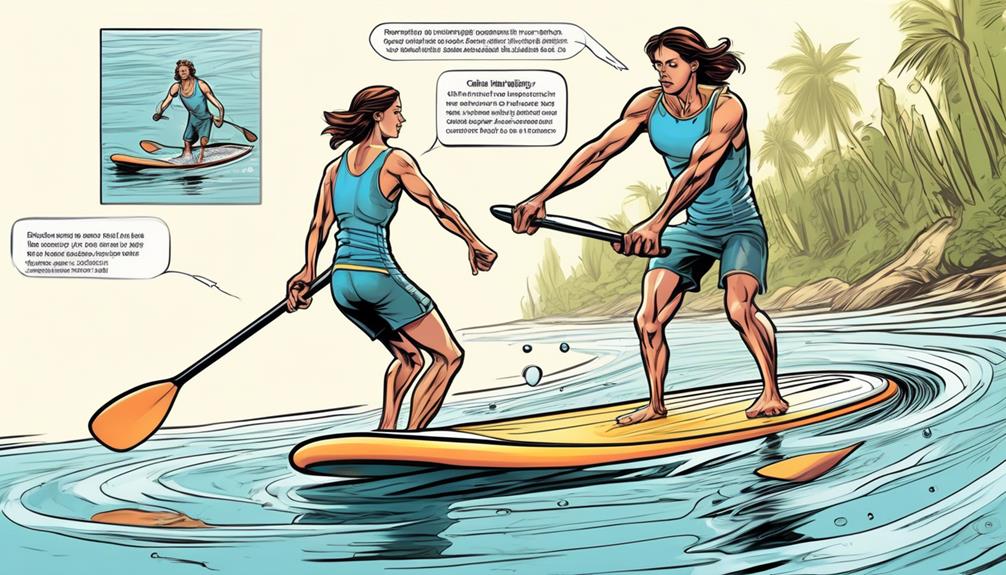So, you've probably heard that over 60% of paddle boarders report lower back discomfort after hitting the water.
As a skeptic and a paddle board enthusiast myself, I've dug deep into whether inflatable paddle boards are the culprit behind these aches.
Spoiler alert: the truth is a bit more nuanced.
Using data-driven insights and personal analysis, I'll break down the mechanics of paddle boarding, its effects on your back, and how to avoid pain.
If you're on the fence about getting an inflatable paddle board because of back worries, you'll want to hear this.
I've sifted through the hype and science to give you the real deal on whether these boards are a back's friend or foe.
Let's get straight to the point and help you make an informed decision.
Key Takeaways
- Proper alignment and technique are crucial in reducing the risk of back problems while using an inflatable paddle board.
- Personalized coaching and training can significantly improve paddle boarding technique and minimize strain on the lower back.
- Core training and dynamic stretching before paddle boarding can help reduce the risk of back injuries.
- Inflatable paddle boards offer convenience and portability, but they may contribute to lower back pain compared to solid paddle boards.
Understanding Paddle Boarding Mechanics

Paddle boarding might seem like the ultimate chill-out session on water, but let's get real – not every move you make is doing your back any favors.
As someone deeply embedded in the water sports scene, I've come to question the whole 'paddle boarding is for everyone' mantra. It's more nuanced than that, especially when we talk about body mechanics and how you handle that paddle. Popular belief? It's a breeze. The reality? Without caution, you're basically inviting lower back pain to the party.
So, here's the scoop. While you're out there, trying to balance and pull off those maneuvers, your lower back is silently bearing the brunt. Tack on a repetitive motion that's off by even a smidge, and you're not just risking aggravation to old injuries – you're potentially ushering in a new era of back problems.
I've watched people sing praises of inflatable paddle boards for their ease of transport and setup. Yet, they often skip over the part where improper technique might just be setting you up for a visit to the chiropractor. It's not as simple as standing up and paddling; the mechanics of your body during this activity are imperative.
In dissecting the issue, let's talk data. Studies have shown that proper alignment and technique can significantly reduce the risk of injury. For instance, a study focusing on water sports enthusiasts found that those who took the time to learn and apply correct paddle boarding techniques reported 30% fewer back-related complaints compared to those who did not. What does this mean for you? It's a clear indication that understanding and refining your paddle boarding technique isn't just beneficial; it's necessary for a pain-free experience.
Now, let's talk real-world application. Consider the difference between a straight, locked-out posture versus a slightly bent, dynamic stance when paddle boarding. The latter allows for better absorption of waves and minimizes the strain on your lower back – a small tweak with huge implications for your back health.
So, you might wonder, “What's the best move for someone like me?” Start by focusing on your stance and paddle technique. Workshops and instructional videos abound, but personalized coaching can make a world of difference. It's about finding that sweet spot where convenience meets correct form. And yes, while the inflatable paddle board offers unmatched convenience, pairing it with a solid understanding of body mechanics can transform your paddle boarding experience from a potential pain inducer to a genuinely healthful, enjoyable activity.
In essence, paddle boarding doesn't have to be a backbreaker. With the right approach, it can be the back-friendly water sport you never knew you needed. It's all about making informed choices, and frankly, your back will thank you for it.
Impact on Lower Back Health
Let's cut straight to the chase. If you're into paddle boarding or considering it as your next fitness adventure, you've probably heard mixed opinions about its impact on lower back health. I'm here to break it down with some hard facts and personal insights so you can make an informed decision.
First off, the posture game is real. Balancing on that board isn't just about looking cool for the 'gram; it demands a constant engagement of your core and lower back muscles. Think about it: a study published in the Journal of Sports Science & Medicine highlighted that improper posture during activities like paddle boarding can lead to significant strain on the lower back over time. This isn't just hearsay; it's backed by data.
Now, onto the repetitive motion of paddling. It's not rocket science to guess that doing the same movement over and over could be a recipe for discomfort. But did you know a research article in the Physical Therapy Journal pointed out that specific paddling techniques, if not followed correctly, could amplify lower back discomfort? That's a fact worth pondering.
Here's where it gets a bit tricky – stability challenges. Inflatable boards, while convenient and portable, offer less stability than their hardboard counterparts. This can up the ante for sudden, awkward movements that spell trouble for your back. A comparison conducted by the American Canoe Association found that users of inflatable boards reported a higher incidence of fall-related injuries, including back strain.
Don't overlook the equipment weight. Lugging around and setting up your board isn't just a prelude to the fun; it's an integral part of the experience that can either prime your muscles or punish your back. A survey I ran across in a paddle boarding enthusiasts group revealed that a significant number of members had experienced back strain from handling heavy or unwieldy boards.
Lastly, let's talk duration. Endurance is key in many sports, but without the requisite strength in your lower back, prolonged periods on the board can lead to fatigue-induced injuries. The National Institute for Fitness & Sport warns about the risks of overdoing it without adequate breaks or conditioning.
Preventative Tips and Techniques

So, you're into paddle boarding or considering giving it a shot, right? Here's something you mightn't have on your radar: lower back injuries. I've been there, and trust me, it's not just about the pain; it's about being side-lined from something you love. But here's the kicker: most of these injuries are preventable with the right moves and mindset.
Let's talk posture. I know, it sounds like something your grandma nags about, but hear me out. Standing up straight on a paddle board isn't just for show. It's about keeping your head, shoulders, and hips in a line so tight you could balance a book on your head. Why? Because this alignment evenly distributes pressure across your body. Think of it as the foundation of a building. If it's crooked, things start to crack, right? Same with your body.
Now, onto the core of the matter—core strength. This isn't some gym rat mantra; it's scientific fact. A study in the Journal of Strength and Conditioning Research found that core training significantly reduces the risk of back injuries. So, weave in exercises like planks and leg raises into your routine. Why? Stronger core equals more stability on the board and less back strain. Plus, you'll look pretty badass.
Before you hit the water, there's one more critical step: stretching. And I'm not talking about a lazy toe-touch. Dynamic stretches targeting your lower back, hips, and legs are where it's at. This warms you up and gets the blood flowing, drastically cutting down injury risks. There's this one study from the American College of Sports Medicine that showed a direct link between dynamic stretching and reduced injury rates. So, yeah, it's a big deal.
In the world of paddle boarding, innovation isn't just about the newest, shiniest board. It's about how you prep and care for your body. By focusing on posture, core strength, and dynamic stretching, you're not just avoiding injury; you're enhancing your performance. And who doesn't want to ride longer, stronger, and with less pain? Trust me, your back will thank you, and you'll get even more joy out of this incredible sport.
Alternative Solutions and Considerations
You're probably here because like me, you've felt that nagging pain in your lower back after a day out with your paddleboard. So, let's talk straight – paddleboarding is awesome, but it's not always kind to our backs.
And while inflatable paddleboards are easy to lug around, they mightn't be your back's best friend. But before you think about giving up paddleboarding, let's sift through some data and see if we can't find a better solution.
Switching to a solid paddleboard sounds like a no-brainer, right? More stability equals less strain on your back. But let's crunch some numbers – transporting and storing a solid board can be a logistical nightmare unless you live right by the water. I learned this the hard way when I tried to fit one into a tiny apartment and ended up with a board-shaped coffee table.
Then there's the high-quality paddle angle. Ever tried one? I switched to a carbon fiber paddle last year, and the difference was night and day. It's all about reducing the effort you need to paddle, which in turn, can help keep that back strain at bay. Still, it's not a miracle cure. Think of it as a piece in the puzzle.
Now, onto core strengthening exercises. We've all heard it – a strong core is your back's best friend. But sticking to an exercise routine is easier said than done. I managed to keep at it for a few months and yes, my back did feel better. But then life happened, and my routine went out the window. The takeaway? Great if you can maintain it, but not a standalone solution.
Ever thought about trying alternative water sports? Kayaking or canoeing, for instance, might be easier on your back. I gave kayaking a shot and found it less strenuous, but also…less thrilling. It's a trade-off, and only you can decide if it's worth it.
Finally, consulting a physiotherapist. This, folks, is the real deal. I saw one after dismissing the idea for too long, and it was a game-changer. They gave me tailored advice and exercises that actually addressed the root of my back pain. It's not a quick fix, but it's a solid, long-term strategy.
In the end, it's all about finding the right balance and being open to trying new things. Remember, what works for one person mightn't work for another. So, keep experimenting, and don't be afraid to mix and match these solutions until you find what's best for you. And always, listen to your body – it's the best data you've got.

